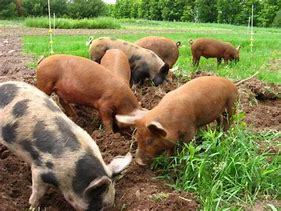

Without correct feeding, a farmer won’t be able to run a profitable pig production business.
To raise healthy pigs, farmers must ensure that their animals receive a nutritious, well-balanced diet at every stage of production.
Suitable ratios
Nutrition is a fairly specialised branch of pig production. Farmers are encouraged farmers to enlist the help of nutritionists to determine suitable rations for their herds.
Rations usually contain an energy source such as maize, wheat or sorghum; protein; vitamins and minerals; and fibre.
Feed should be formulated based on a pig’s stage of production, energy and protein requirements.
Certain raw materials should not be used in excess.For example, if there’s too much sunflower oil cake, the fibre content will be too high.
Keep a close eye on the feed conversion ratio (FCR) of your pigs. FCR means the quantity of feed a pig needs for every kilogramme of carcass mass it produces and that the farmer ultimately sells.
Farmers know the average daily growth (ADG) of pigs.
Knowing these things will tell you what your profit margins will be.
Breeding herds
A breeding herd needs a proper diet for good reproductive performance. A breeding herd requires different rations during pregnancy and lactation.
Pregnancy rations should contain lower energy ingredients with a relatively high fibre content.
Calcium, phosphorus and minerals should also be included in the diet.
Lactation rations are fed to sows after they’ve delivered their litters and should be designed to meet the needs of milk production.
This diet should have a high content of calcium, phosphorous and protein, and lesser quantities of fibre.
Newly weaned pigs
Balanced nutrition for newly weaned pigs is crucial, particularly for enzyme production and acid control.
This phase in the production cycle lasts four to 10 weeks. This is one of the most important phases in the production cycle, from a nutritional point of view.
The ration needs a high milk or whey powder content, as the pigs will still be accustomed to receiving the milk they had as piglets.
Whey is the liquid remaining after milk has been curdled and strained and is a by-product in the manufacture of cheese.
This formulation will help their digestive systems with enzyme production.
As the piglets get older, their enzyme system will change so that they can better digest carbohydrates and starches.
If the diet doesn’t match the abilities of the pig’s digestive system, it won’t perform properly. And undigested food in a pig’s stomach can lead to disease.
Grower – Finisher pigs
Pigs in this phase of production should receive a different ration every 2 to 3 weeks.
This is necessary to cater for the growing pig’s changing energy and protein needs.
If you feed only one type of ration, you’ll either under- or over-provide essential nutrients.
Grower-finisher rations are designed to optimise the growth and carcass quality of pigs.
Home mix or Pre-mix
On-farm mixing can be more cost-effective, as farmers don’t have to pay additional milling and mixing costs.
But it must be done accurately for the pigs to get maximum benefit from the feed.
If your feed requirement is 100 tons or more a month, it would be viable to put up your own mixing plant.
The texture of the feed is also important and has a great influence on pig performance.
Feed should not be too finely ground, otherwise it will cake, and if it is too chunky it will be difficult to digest.
A good rule of thumb is 700 microns to 800 microns – this is roughly the size of a pinhead.
If the budget allows, farmers could also consider buying pelleted food from feed mills.
This will reduce dust in the sties (which can cause respiratory irritation in pigs).
It will also reduce wastage and improve feed efficiency.
Feeding Bins
Install the correct type of feed dispensers and you’ll avoid wasting feed.
Farmers should use single-space feeders, instead of multi-feeders.
This will ensure that only one pig eats at a time.
Multi-space feeders could effectively cause you to lose about 20% of your feed through wastage.
Although single-space feeders may cost more, you’ll waste less feed.
Feeding dos and donts
Farmers should not feed pigs kitchen, restaurant or hospital waste.
The energy and protein content of rations will not be consistent and it can bring disease on to a farm.
This is crucial for biosecurity on the farm.
But it is acceptable to feed rejected breakfast cereal, dog biscuits or brewers grain to pigs, as there is usually nothing wrong with product quality and consistency. This is one option to help reduce overall feeding costs.
 Contact Jaguza Support
Contact Jaguza Support